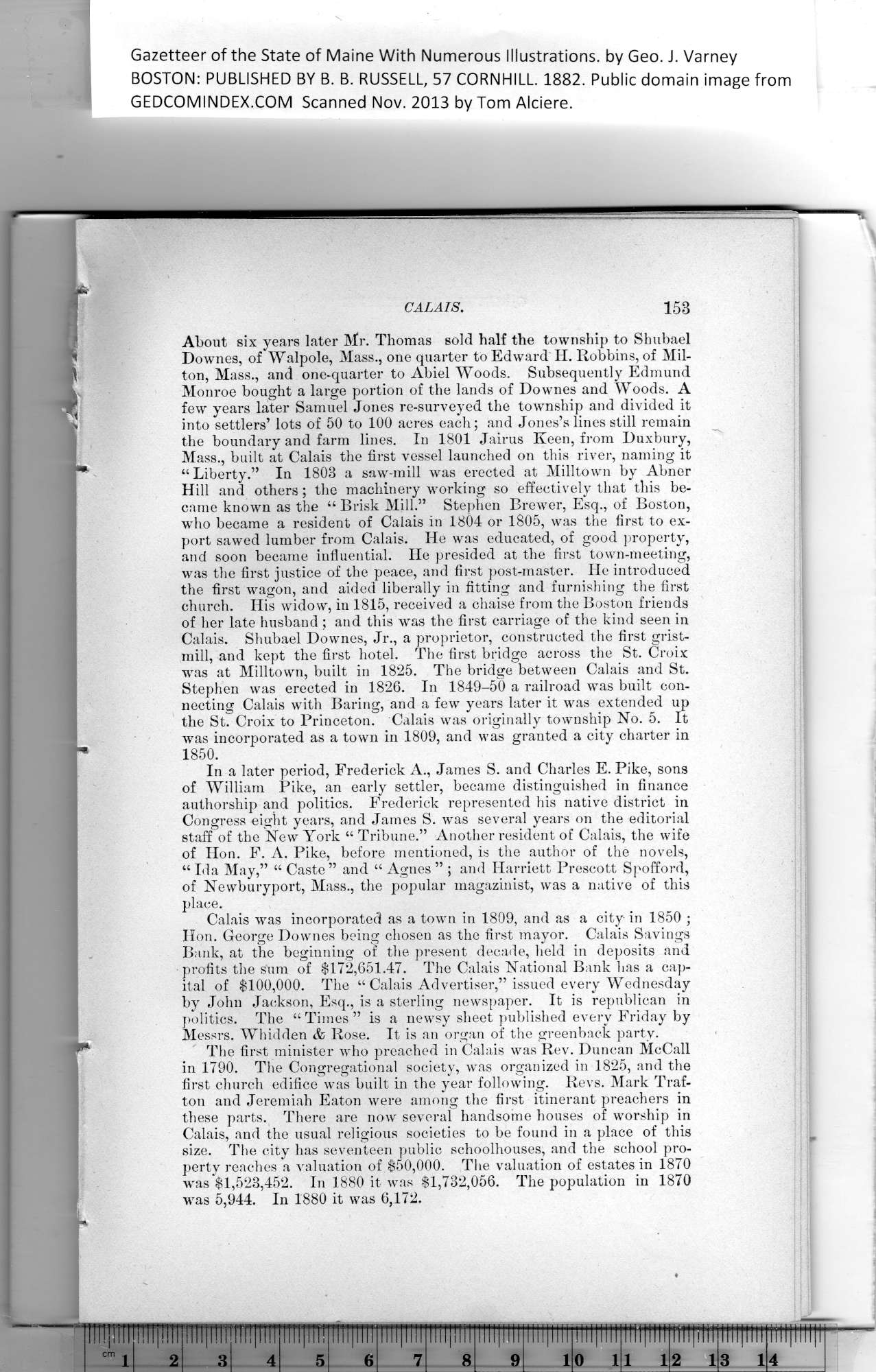|
Gazetteer of the State of Maine With Numerous Illustrations, by Geo. J. Varney
BOSTON: PUBLISHED BY B. B. RUSSELL, 57 CORNHILL. 1882. Public domain image from
CALAIS. 153
About six years later Mr. Thomas sold half the township to Shubael
Downes, of Walpole, Mass., one quarter to Edward H. Robbins, of Mil-
ton, Mass., and one-quarter to Abiel Woods. Subsequently Edmund
Monroe bought a large portion of the lands of Downes and Woods. A
few years later Samuel Jones re-surveyed the township and divided it
into settlers’ lots of 50 to 100 acres each; and Jones’s lines still remain
the boundary and farm lines. In 1801 Jairus Keen, from Duxbury,
Mass., built at Calais the first vessel launched on this river, naming it
“Liberty.” In 1803 a saw-mill was erected at Milltown by Abner
Hill and others; the machinery working so effectively that this be-
came known as the “ Brisk Mill.” Stephen Brewer, Esq., of Boston,
who became a resident of Calais in 1804 or 1805, was the first to ex-
port sawed lumber from Calais. He was educated, of good property,
and soon became influential. He presided at the first town-meeting,
was the first justice of the peace, and first post-master. He introduced
the first wagon, and aided liberally in fitting and furnishing the first
church. His widow, in 1815, received a chaise from the Boston friends
of her late husband; and this was the first carriage of the kind seen in
Calais. Shubael Downes, Jr., a proprietor, constructed the first grist-
mill, and kept the first hotel. The first bridge across the St. Croix
was at Milltown, built in 1825. The bridge between Calais and St.
Stephen was erected in 1826. In 1849-50 a railroad was built con-
necting Calais with Baring, and a few years later it was extended up
the St. Croix to Princeton. Calais was originally township No. 5. It
was incorporated as a town in 1809, and was granted a city charter in
1850.
In a later period, Frederick A., James S. and Charles E. Pike, sons
of William Pike, an early settler, became distinguished in finance
authorship and politics. Frederick represented his native district in
Congress eight years, and James S. was several years on the editorial
staff of the New York “ Tribune.” Another resident of Calais, the wife
of Hon. F. A. Pike, before mentioned, is the author of the novels,
“ Ida May,” “ Caste ” and “ Agnes ” ; and Harriett Prescott Spofford,
of Newburyport, Mass., the popular magazinist, was a native of this
place.
Calais was incorporated as a town in 1809, and as a city in 1850 ;
Hon. George Downes being chosen as the first mayor. Calais Savings
Bank, at the beginning of the present decade, held in deposits and
profits the sum of $172,651.47. The Calais National Bank lias a cap-
ital of $100,000. The “ Calais Advertiser,” issued every Wednesday
by John Jackson, Esq., is a sterling newspaper. It is republican in
politics. The “Times” is a newsy sheet published every Friday by
Messrs. Whidden & Rose. It is an organ of the greenback party.
The first minister who preached in Calais was Rev. Duncan McCall
in 1790. The Congregational society, was organized in 1825, and the
first church edifice was built in the year following. Revs. Mark Traf-
ton and Jeremiah Eaton were among the first itinerant preachers in
these parts. There are now several handsome houses of worship in
Calais, and the usual religious societies to be found in a place of this
size. The city has seventeen public schoolhouses, and the school pro-
perty reaches a valuation of $50,000. The valuation of estates in 1870
was $1,523,452. In 1880 it was $1,732,056. The population in 1870
was 5,944. In 1880 it was 6,172.
PREVIOUS PAGE ... NEXT PAGE
This page was written in HTML using a program written in Python 3.2
|
